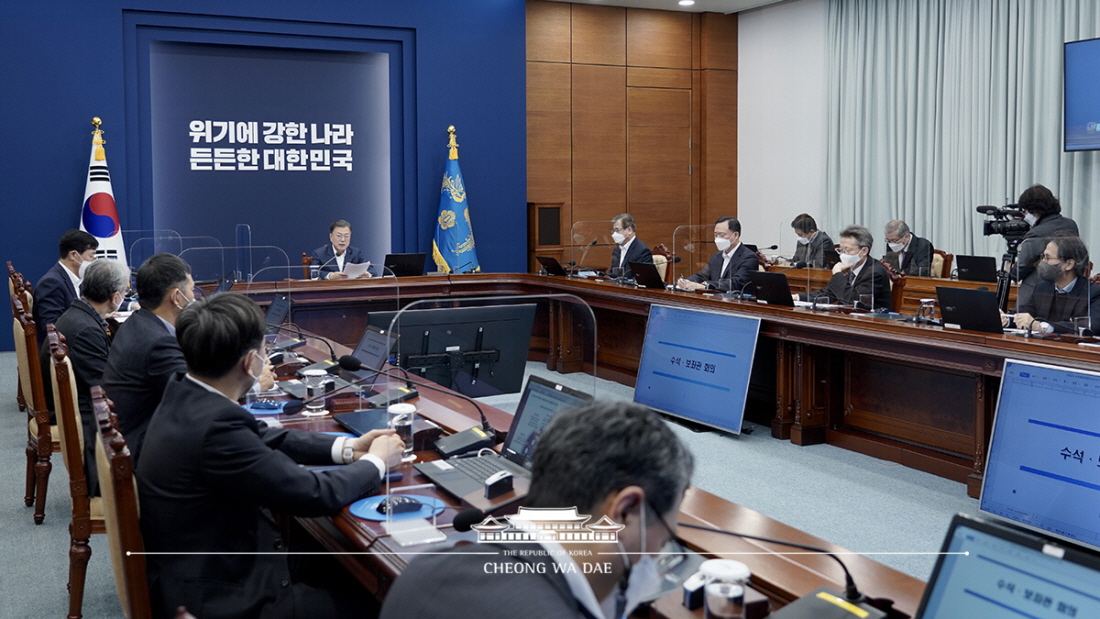이 웹사이트는 제19대 대통령 임기 종료에 따라 대통령기록관이 「대통령기록물 관리에 관한 법률」에 의해 이관받아 서비스하는 대통령기록물입니다. 자료의 열람만 가능하며 수정 · 추가 · 삭제는 불가능합니다.
다만, 「개인정보보호법」에 의하여 개인의 정보를 보호받기 원하시는 분은 관련 내용(요청자, 요청내용, 연락처, 글위치)을 대통령 웹기록물 담당자(044-211-2253)에게 요청해 주시면 신속히 검토하여 조치해 드리겠습니다. 감사합니다.
SPEECHES & REMARKS
BRIEFINGS
Opening Remarks by President Moon Jae-in at Meeting with His Senior Secretaries

The agenda item for today’s meeting is the welfare state. Here with us for presentations and discussions are three outside experts – President Lee Tae-soo of the Korea Institute for Health and Social Affairs, Professor Kim Yeon-myung from Chung-Ang University’s School of Social Welfare and Social Welfare Studies Professor Yoon Hong-sik from Inha University’s College of Social Science. Thank you for joining us. Please give them a hand and welcome them.
Our Government’s Omicron response system is currently aiming at maintaining our ability to provide needed medical care with a focus on handling severely or critically ill patients. This is to effectively protect people’s lives and safety by concentrating our capabilities on lowering the chance of them becoming severely or critically ill or dying, even as the number of confirmed cases increases. It is based on the lessons from the exploding case counts in other countries that led to surges in fatalities. Moreover, we can tackle the Omicron wave and move toward a return to normal only if we are able to maintain our capacity to provide medical care whenever needed.
The number of new confirmed cases has been exceeding 100,000 per day recently. However, this is within the scope of previous estimates, and the situation has not become as difficult as feared. Actually, as of yet, the number of severely or critically ill patients prioritized for care by the Government has remained stable – under half of what had been predicted by disease control authorities and experts. The case fatality rate is also falling, and hospital bed occupancy is staying at stable levels.
All of this is the result of the efforts to secure a sufficient number of hospital beds in advance, vaccinate people and import oral medication earlier than scheduled while delaying as much as possible the rampant spread of the Omicron variant. Our preemptive switch to a response system focused on those patients who are severely or critically ill has played a role, too.
The Government’s recent adjustment of social distancing rules was also possible because the rate of patients who become severely or critically ill and the fatality rate as well as our medical response capacity were kept stable despite a surge in confirmed cases. With the COVID-19 pandemic dragging on, it is very difficult to determine the appropriate level of social distancing. Views vary depending on who is speaking and what their situation is. Epidemic prevention and control experts are concerned that the spread of Omicron has yet to reach its peak, and microbusiness owners and the self-employed are deeply dissatisfied that business hours have been extended only a bit. The Government knows well that microbusiness owners and the self-employed are facing difficulties; our decision came only after arduous deliberations amid the increasing number of confirmed cases. I ask for people’s understanding. Going forward, we will flexibly adjust social distancing as the situation changes, keeping the focus on taking care of severely or critically ill patients and our ability to provide needed medical care.
It is very fortunate that we have overcome the initial confusion caused by the complete reorganization of epidemic prevention and medical responses and have recently been regaining stability across the board. Above all, the reorganized testing and treatment system is swiftly taking root. The number of hospitals and clinics assisting with at-home treatments has exceeded our target, reaching over 6,200, and a total of 200 round-the-clock medical counseling centers are also in operation. As such, medical professionals’ active participation and cooperation are playing an immense role. I am deeply grateful.
The Government will focus on preventing serious illnesses by further increasing the number of participating hospitals and medical counseling centers to intensively manage high-risk groups. At the same time, we will also do all we can to provide guidance, consultation and sufficient information to those under general management – the majority of confirmed patients receiving at-home treatment – to help relieve any anxiety should they feel neglected.
Instability over the supply and demand of diagnostic kits is quickly subsiding. Their production has been significantly expanded, and price controls have been implemented by simplifying the distribution channels to pharmacies and convenience stores. Meanwhile, the Government is securing as many of the kits as possible for public institutions to gradually expand the number supplied for free. From today, they will be distributed at no cost to daycare centers and welfare facilities for seniors. They also will be provided free of charge to elementary, middle and high school students once school starts.
It is very worrisome that the number of confirmed cases among children and adolescents is sharply rising prior to the beginning of school. The education and disease control authorities should do everything possible to look into problems on the frontlines of education and ensure that epidemic prevention efforts at schools are not disrupted. Most of all, I ask the related authorities to actively communicate with students, parents and teachers. Vaccination is still important. High-risk groups staying in nursing hospitals and other facilities will start receiving their fourth doses today. I hope that those who have not been vaccinated due to concerns over side effects will actively use the vaccine produced by Novavax.
All countries around the world are undergoing the Omicron crisis together, and we have been responding relatively well at least to date. Now, it will not be long before the spread of Omicron reaches its peak. If we pull through this period well, we’ll be able to move more confidently toward recovering our daily lives. I ask the people to put their faith in the Government and stay confident.



